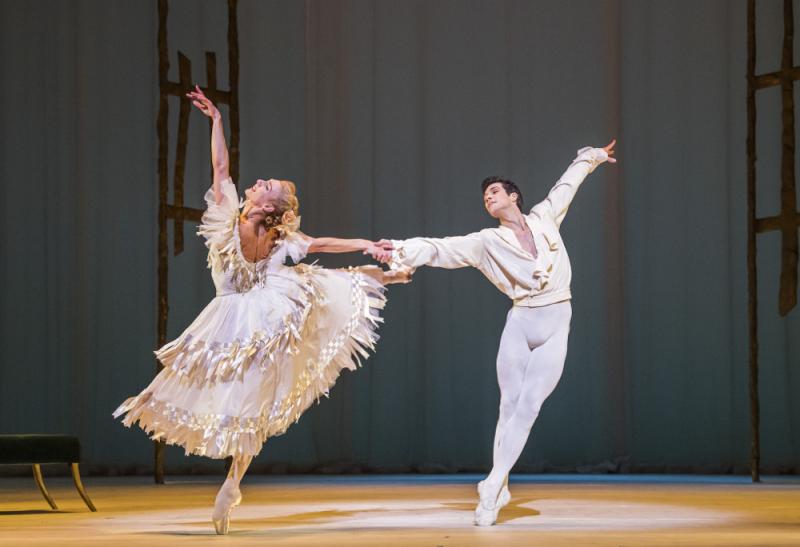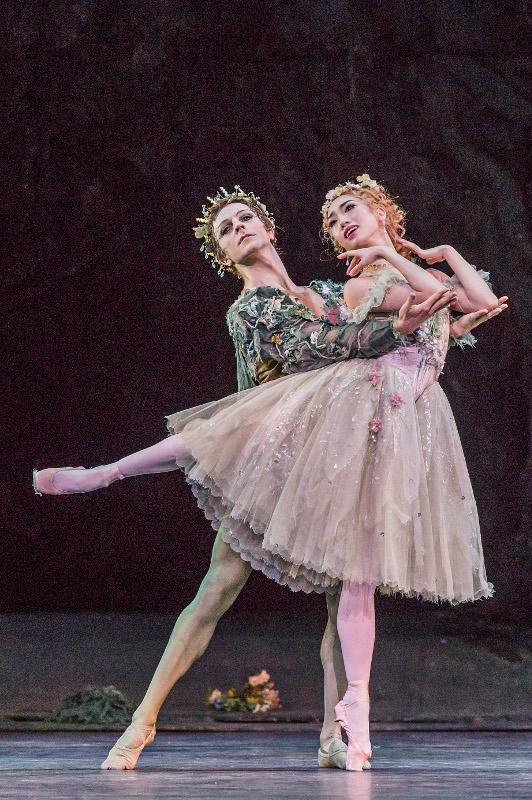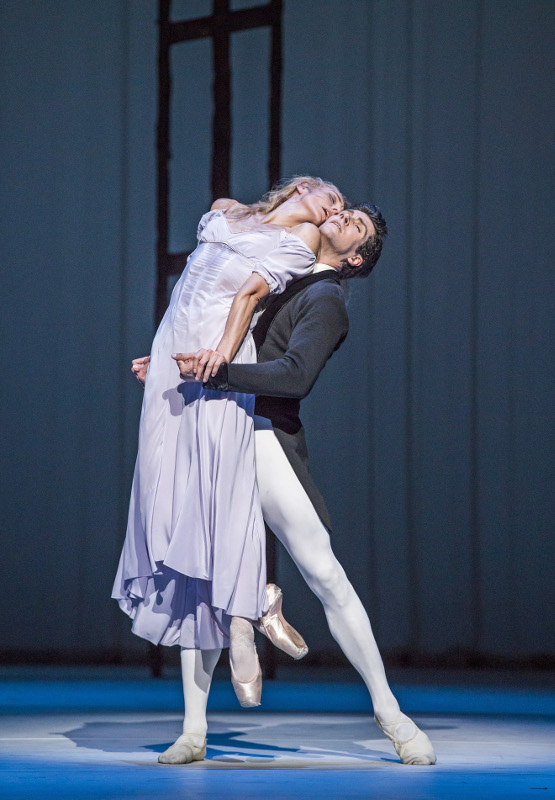Ashton triple bill, Royal Ballet review – fond farewell to Zenaida Yanowsky | reviews, news & interviews
Ashton triple bill, Royal Ballet review – fond farewell to Zenaida Yanowsky
Ashton triple bill, Royal Ballet review – fond farewell to Zenaida Yanowsky
The prima ballerina bows out in 'Marguerite and Armand' as Akane Takada makes a lovely debut in 'The Dream'

Nicely covering the many bases of Frederick Ashton's genius, the Royal Ballet triple bill which opened last night is a chance to see both the company and its founder choreographer on top form.
 The Dream is one of the loveliest one-acters there is, and the Royal do it beautifully. Last night, Akane Takada made a very pretty debut as Titania. With her tiny frame, Takada is a convincing fairy, but she is also a convincing interpreter of Ashton: her amorous encounters with both Bottom (Bennet Gartside, sweet as always) and her husband Oberon (pictured right) sparkled with that inimitable Ashton sexiness, all orgasmic flutters and shivers. McRae is splendidly fey as Oberon, and has all the sprezzatura that taller dancers struggle to find in the part's show-off turning variations. All four of the human lovers handled their comedy antics with aplomb; spiky Itziar Mendizabal is particularly funny as Helena, confused by Demetrius's sudden change of heart. Valentino Zucchetti's Puck looked surprisingly stilted at times - surprisingly because the last time I saw him in this role, he seemed to be made of rubber, and his bouncy levity was a joy to behold. The corps de ballet, the four leading fairies, the orchestra under Emmanuel Plasson and the London Oratory Junior Choir were all perfectly in tune with the spirit of the piece: the warm tones and airy fantasies of Mendelssohn matched to the charming, rustling flights of petit allegro Ashton gave to the corps as fairies.
The Dream is one of the loveliest one-acters there is, and the Royal do it beautifully. Last night, Akane Takada made a very pretty debut as Titania. With her tiny frame, Takada is a convincing fairy, but she is also a convincing interpreter of Ashton: her amorous encounters with both Bottom (Bennet Gartside, sweet as always) and her husband Oberon (pictured right) sparkled with that inimitable Ashton sexiness, all orgasmic flutters and shivers. McRae is splendidly fey as Oberon, and has all the sprezzatura that taller dancers struggle to find in the part's show-off turning variations. All four of the human lovers handled their comedy antics with aplomb; spiky Itziar Mendizabal is particularly funny as Helena, confused by Demetrius's sudden change of heart. Valentino Zucchetti's Puck looked surprisingly stilted at times - surprisingly because the last time I saw him in this role, he seemed to be made of rubber, and his bouncy levity was a joy to behold. The corps de ballet, the four leading fairies, the orchestra under Emmanuel Plasson and the London Oratory Junior Choir were all perfectly in tune with the spirit of the piece: the warm tones and airy fantasies of Mendelssohn matched to the charming, rustling flights of petit allegro Ashton gave to the corps as fairies.
Symphonic Variations (1946) (pictured below left) tends to send writers off on exuberant rhetorical flights as they try to explain what's so marvellous about it. I can't even apologise for joining in; it's just too delicious. The neoclassical graces of Balanchine's Apollo are combined with Ashton's own famed lightness of touch and step: six dancers trip and glide airily across the stage, not in the fussy, fairy fashion of Dream, but with a joyful serenity that suggests angels, minor deities, or perhaps the souls of the blessed. The black armbands worn by two of the male dancers nod at the still-fresh wounds of wartime bereavement, but one feels here that Ashton, who had been reading St Teresa of Avila, wanted to see the dead in happy communion with eternity: this is not an anthem for doomed youth but a vision of paradise regained. In their trim white costumes, against a backdrop green like sun-bleached grass, the dancers could be so many gilded debs, magically restored to a pre-war idyll of eternal summer, lawn tennis and house parties. And yet, the shadows of suffering are there in the seriousness, the poise and the patience displayed in the steps. The main couple wait for what seems like an age, quite still, on opposite sides of the stage, while the other four whirl distractingly between them: when they finally come together it is with the deep joy of longed-for reunion.
 It was in this piece three years ago that I first saw Marianela Nuñez partnered by Vadim Muntagirov, and observed the germ of the glowing partnership theirs has now become. Last night's performance drove home how beautifully Muntagirov is developing. The sweetness of character, the golden elegance of body he has always had are still there, but now suffused with a magnetic dignity and command. The boy is becoming a man. For several minutes at the beginning, Muntagirov stands stock still with his back to the audience while the three women dance in front of him; my eye was drawn to him more than the ladies, so centred and assured is his presence. He has danced Apollo before, but not, I think, recently: splendid as a young god, it's surely time to give him the role again. Franck's Variations Symphoniques were handled slightly too heavily for my taste in the first half by Paul Stobart on the piano, but the last three sections were as heartfelt as one could wish, building to an exuberant climax that would – surely – wring a smile from a corpse.
It was in this piece three years ago that I first saw Marianela Nuñez partnered by Vadim Muntagirov, and observed the germ of the glowing partnership theirs has now become. Last night's performance drove home how beautifully Muntagirov is developing. The sweetness of character, the golden elegance of body he has always had are still there, but now suffused with a magnetic dignity and command. The boy is becoming a man. For several minutes at the beginning, Muntagirov stands stock still with his back to the audience while the three women dance in front of him; my eye was drawn to him more than the ladies, so centred and assured is his presence. He has danced Apollo before, but not, I think, recently: splendid as a young god, it's surely time to give him the role again. Franck's Variations Symphoniques were handled slightly too heavily for my taste in the first half by Paul Stobart on the piano, but the last three sections were as heartfelt as one could wish, building to an exuberant climax that would – surely – wring a smile from a corpse.
Marguerite and Armand is like one of those temperamental plants that thrive only in very specific conditions, the ones that gardeners seem doomed to find always either wilting from too much sun, rotting from too much water, or succumbing wanly to aphids. An impressionistic retelling of the Dame aux Camélias plot (cf La Traviata), its filmic montage of set-pieces stands or falls by the chemistry between the main characters, which must be so violent, so compelling, that we have no attention spare to notice the creakings of melodrama or the quite challenging lifts in the pas de deux. Famously a vehicle for Fonteyn and Nureyev, some think it should have died with them. Tamara Rojo's extraordinary farewell performance with Sergei Polunin in 2013 prevents me from sharing that opinion, but the Ashton Foundation's recent willingness to license practically any casting is a huge mistake.
 I sympathise with the impulse which prompted Kevin O'Hare to give retiring dramatic ballerina Zenaida Yanowsky another crack at Marguerite for her last run at the Opera House, and to her credit, she throws herself at it body and soul. But she's just too tall, even for imported Italian stallion Roberto Bolle: in the famous final pas de deux (pictured right), where the lady of the camellias is supposed to look like she's floating up to heaven, Bolle must bend backwards at a nasty angle to get Yanowsky's feet high enough off the ground. Plus, handsome and committed he may be, but at 42, Bolle is actually older than Yanowsky and, with all the goodwill in the world, doesn't look much like a lovesick youth.
I sympathise with the impulse which prompted Kevin O'Hare to give retiring dramatic ballerina Zenaida Yanowsky another crack at Marguerite for her last run at the Opera House, and to her credit, she throws herself at it body and soul. But she's just too tall, even for imported Italian stallion Roberto Bolle: in the famous final pas de deux (pictured right), where the lady of the camellias is supposed to look like she's floating up to heaven, Bolle must bend backwards at a nasty angle to get Yanowsky's feet high enough off the ground. Plus, handsome and committed he may be, but at 42, Bolle is actually older than Yanowsky and, with all the goodwill in the world, doesn't look much like a lovesick youth.
Bringing in an external star also militates against the chance that the pairing will be lent oomph by the spark of a pre-existing partnership, which of course was precisely what made the Fonteyn/Nureyev piece work. When Armand rushes into the party, locks eyes with Marguerite, and WHAM! both experience a coup de foudre, I see Nureyev, who famously used to hurtle across the studio to embrace Fonteyn when they rehearsed together. In the fragile ecstasies of Marguerite I see the middle-aged Fonteyn, whose fading career was given quite unexpected new life by the young Russian emigré. Ashton was quite capable of creating steps to create certain emotions, but here he created them to express emotions that already existed.
It's not the dancers' fault here: they both did their best (unlike Diana Vishneva a couple of years ago, who flagrantly sulked when she had to perform it with a partner she clearly thought inappropriate). But it shouldn't have been cast this way. In this run two more company dancers will perform with imported stars: Natalia Osipova with the Mariinsky's Vladimir Shklyarov (and not former Royal Ballet dancer, fine Armand, and her current boyfriend Sergei Polunin as originally intended), and Federico Bonelli with retired La Scala principal Alessandra Ferri; it will be interested to see whether they do better.
As to supporting characters, music etc - well, the Liszt piano sonata in B Minor in Robert Clark's hands hammered us over the head with drama, Christopher Saunders plays Armand's father stiffly, the admirers in the party scene pootle about. Like I said: it stands or falls on the principals' chemistry, and last night was a fall. I'm glad for Yanowsky that she was so splendid in Liam Scarlett's Symphonic Dances last month; for my taste, that was a more fitting valediction for this intelligent, powerful principal. She will be missed.
- The Royal Ballet perform The Dream/Symphonic Variations/Marguerite and Armand at the Royal Opera House until 10 June. The triple bill will be broadcast live to cinemas around the world on Wednesday 7 June.
- Read more dance articles on theartsdesk
rating
Share this article
Add comment
The future of Arts Journalism
You can stop theartsdesk.com closing!
We urgently need financing to survive. Our fundraising drive has thus far raised £49,000 but we need to reach £100,000 or we will be forced to close. Please contribute here: https://gofund.me/c3f6033d
And if you can forward this information to anyone who might assist, we’d be grateful.

Subscribe to theartsdesk.com
Thank you for continuing to read our work on theartsdesk.com. For unlimited access to every article in its entirety, including our archive of more than 15,000 pieces, we're asking for £5 per month or £40 per year. We feel it's a very good deal, and hope you do too.
To take a subscription now simply click here.
And if you're looking for that extra gift for a friend or family member, why not treat them to a theartsdesk.com gift subscription?
more Dance
 'We are bowled over!' Thank you for your messages of love and support
Much-appreciated words of commendation from readers and the cultural community
'We are bowled over!' Thank you for your messages of love and support
Much-appreciated words of commendation from readers and the cultural community
 R:Evolution, English National Ballet, Sadler's Wells review - a vibrant survey of ballet in four acts
ENB set the bar high with this mixed bill, but they meet its challenges thrillingly
R:Evolution, English National Ballet, Sadler's Wells review - a vibrant survey of ballet in four acts
ENB set the bar high with this mixed bill, but they meet its challenges thrillingly
 Like Water for Chocolate, Royal Ballet review - splendid dancing and sets, but there's too much plot
Christopher Wheeldon's version looks great but is too muddling to connect with fully
Like Water for Chocolate, Royal Ballet review - splendid dancing and sets, but there's too much plot
Christopher Wheeldon's version looks great but is too muddling to connect with fully
 iD-Reloaded, Cirque Éloize, Marlowe Theatre, Canterbury review - attitude, energy and invention
A riotous blend of urban dance music, hip hop and contemporary circus
iD-Reloaded, Cirque Éloize, Marlowe Theatre, Canterbury review - attitude, energy and invention
A riotous blend of urban dance music, hip hop and contemporary circus
 How to be a Dancer in 72,000 Easy Lessons, Teaċ Daṁsa review - a riveting account of a life in dance
Michael Keegan-Dolan's unique hybrid of physical theatre and comic monologue
How to be a Dancer in 72,000 Easy Lessons, Teaċ Daṁsa review - a riveting account of a life in dance
Michael Keegan-Dolan's unique hybrid of physical theatre and comic monologue
 A Single Man, Linbury Theatre review - an anatomy of melancholy, with breaks in the clouds
Ed Watson and Jonathan Goddard are extraordinary in Jonathan Watkins' dance theatre adaptation of Isherwood's novel
A Single Man, Linbury Theatre review - an anatomy of melancholy, with breaks in the clouds
Ed Watson and Jonathan Goddard are extraordinary in Jonathan Watkins' dance theatre adaptation of Isherwood's novel
 Peaky Blinders: The Redemption of Thomas Shelby, Rambert, Sadler's Wells review - exciting dancing, if you can see it
Six TV series reduced to 100 minutes' dance time doesn't quite compute
Peaky Blinders: The Redemption of Thomas Shelby, Rambert, Sadler's Wells review - exciting dancing, if you can see it
Six TV series reduced to 100 minutes' dance time doesn't quite compute
 Giselle, National Ballet of Japan review - return of a classic, refreshed and impeccably danced
First visit by Miyako Yoshida's company leaves you wanting more
Giselle, National Ballet of Japan review - return of a classic, refreshed and impeccably danced
First visit by Miyako Yoshida's company leaves you wanting more
 Quadrophenia, Sadler's Wells review - missed opportunity to give new stage life to a Who classic
The brilliant cast need a tighter score and a stronger narrative
Quadrophenia, Sadler's Wells review - missed opportunity to give new stage life to a Who classic
The brilliant cast need a tighter score and a stronger narrative
 The Midnight Bell, Sadler's Wells review - a first reprise for one of Matthew Bourne's most compelling shows to date
The after-hours lives of the sad and lonely are drawn with compassion, originality and skill
The Midnight Bell, Sadler's Wells review - a first reprise for one of Matthew Bourne's most compelling shows to date
The after-hours lives of the sad and lonely are drawn with compassion, originality and skill
 Ballet to Broadway: Wheeldon Works, Royal Ballet review - the impressive range and reach of Christopher Wheeldon's craft
The title says it: as dancemaker, as creative magnet, the man clearly works his socks off
Ballet to Broadway: Wheeldon Works, Royal Ballet review - the impressive range and reach of Christopher Wheeldon's craft
The title says it: as dancemaker, as creative magnet, the man clearly works his socks off
 The Forsythe Programme, English National Ballet review - brains, beauty and bravura
Once again the veteran choreographer and maverick William Forsythe raises ENB's game
The Forsythe Programme, English National Ballet review - brains, beauty and bravura
Once again the veteran choreographer and maverick William Forsythe raises ENB's game

Comments
I think it is a shame that
I quite agree. I could not
We saw the video feed of